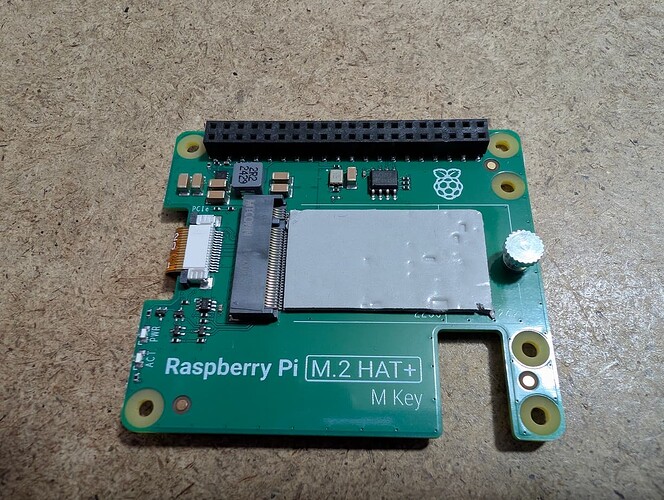I have the subject case with a 16 GB RPi 5 and the NVMe PIP loaded with a Lexar NM620 1 TB SSD and the NVMe Hailo-8L accelerator portion of the Raspberry Pi AI Kit. I took some thermal image pictures and noted high heat on the NVMe PIP. When I initially removed the Hailo M.2 card from the AI Kit HAT, there was a thermal pad between the two. Are there any recommendations for thermal pad placement in this Pironman 5 MAX configuration, or is air flow through the case sufficient to cool these bits?
The AI Kit is not equipped with thermal pads for cooling.
Our Pironman 5 Max does not come with thermal pads for the SSD.
We use RGB fans for cooling inside the case, which includes cooling for the NVMe PIP.
You can also prepare thermal pads for the SSD for additional cooling.
Attached is an untouched AI Kit HAT with Hailo M.2 removed and thermal pad clearly visible. Thought this was unnecessary myself as there is no real thermally conductive surface under the pad.
Think I will use the performance setting for the RGB fans for more aggressive cooling, just to be safe. Thanks.
The official AI Kit does not include any thermal pads in its package. It’s quite unusual to find a thermal pad on your HAT+, as you correctly pointed out - thermal pads should be applied to the AI Hailo module instead, not the HAT+.
Please note that the AI Kit is an official Raspberry Pi product, and its entire design was developed by Raspberry Pi’s engineering team. You can review the complete list of included accessories in the AI Kit through the official documentation here:
I found the reason on the Raspberry Pi AI Kit product page:
https://www.raspberrypi.com/products/ai-kit/
In the Specifications, line 3, it says:
Thermal pad pre-fitted between module and HAT+ spreads heat across components, improving performance.
Not for protection then, but to improve performance. I might just relocate the pad from the HAT board to the NVMe PIP for general purposes and to get maximum performance.
Yes,this is the official design, but you can also customize it according to your ideas!
While I was working on another Pironman 5 MAX issue (detailed after this entry), I took a closer look at the spot where the AI Kit Hailo M.2 card is mounted on the NVMe PIP. Earlier in this thread, I posted the fact that a thermal pad was placed between the Hailo M.2 card and the M.2 HAT board in the original AI Kit. I was asking a moderator or anyone if a thermal pad should still be used in the Pironman. I would say no. When the Hailo M.2 card is mounted on the Pironman NVMe PIP (so many acronyms…), there is a good quarter inch of standoff between the two. Earlier in the thread I posted a picture of the M.2 HAT showing the pad with several indentations where components from the underside of the Hailo M.2 card impinged. The underside of that card looks like the Manhattan skyline. The thermal pad is not really adhesive and will likely settle out of contact with the board after a couple of heating duty cycles. So I will leave the job to air cooling which seems satisfactory.
The heatsink of Pironman 5 MAX is also attached directly to the SSD, not between the SSD and the NVMe PIP.
The heatsink is attached to the SSD to transfer the heat from the SSD to the heatsink, which is then expelled from the case by the fan.
I beg to differ. The large heat sink associated with the tower cooler only services the RPi 5 board. The Lexar NM620 SSD I have mounted on the NVMe PIP board might have its own heat dissipation scheme. There is a thin, possibly semi-metallic plate on the top surface of the card adhering to all of the memory chips. I will do some more thermal imaging studies to verify this.
The tower cooler you mentioned is specifically designed for the PI5. The thermal pad is applied to the IC of the PI5, and then the cooler is fixed above the PI5 and the thermal pad to facilitate heat transfer.
On the other hand, the SSD has its own cooling solution, which involves attaching a heatsink directly to the SSD. This allows the heat generated by the SSD to be transferred to the surface of the heatsink, and the fan then expels this heat out of the case.
Finally, wish you success with your project!
I mounted my M.2 sticks in minimal heat shield cases. (Lexar 1TB)
I discovered that the tiny screws on the touching sides made the cases too thick to fit. I removed the touching screws, and got the M.2 sticks to fit, though still very tight.
The connections are good and solid, thus when I finish the assembly we shall see how this works.
Thanks, Peter
Yes, very close tolerances inside the MAX case. Most if not all M.2 cards have a unifying cover and label applied on the upper surface and in contact with all of the memory chips. If you have worked with SSD cards you know that they do get pretty warm in operation. There may be some heat dissipation effect associated with the cover, but I think more importantly it serves to spread and equalize the heat across the component. I’ve read in product literature that this can improve performance. I have done a couple of thermal imaging studies of the NVMe PIP in operation with a 1 TB M.2 card and the Hailo-8L AI accelerator onboard. With the RGB fans set to the Performance setting (think they cycle on at 50 C) everything stays pretty cool.
